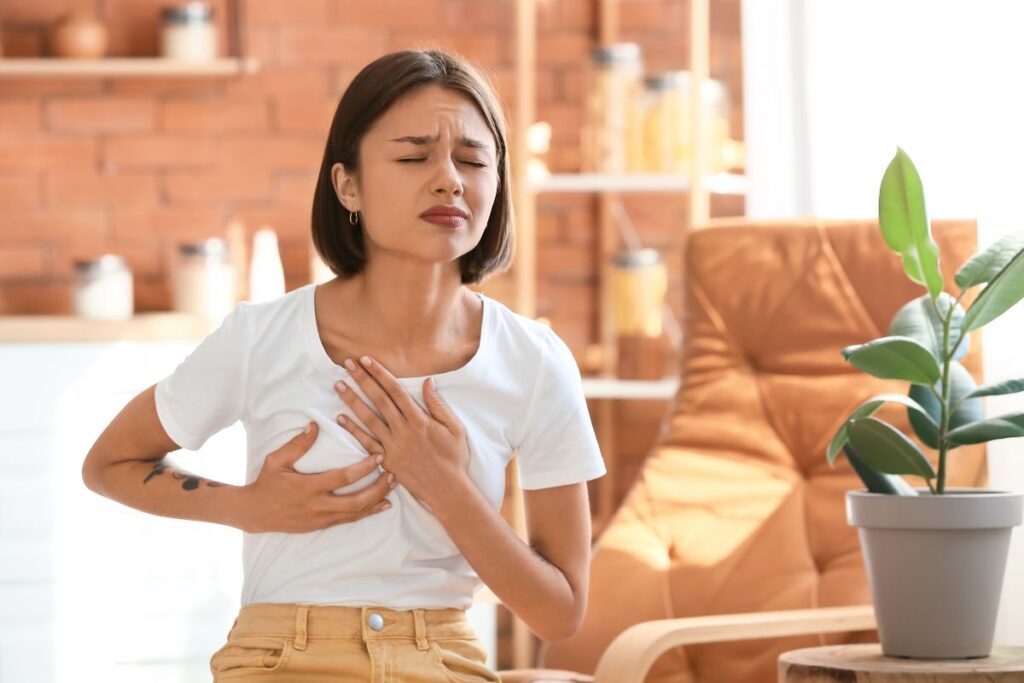Mastalgia, another name for breast pain, is a common and, at times,s concerning issue for many women. Breast pain can be subtle, throbbing, or acute, and it can happen for various reasons or at different times during the menstrual cycle. If you’ve ever experienced breast tenderness, you might be wondering what it means, whether it’s normal, and when it could signal something more serious. In this article, we’ll explore the various causes of breast pain, how to manage it, and the red flags that may require medical attention.
What Causes Breast Pain?
Numerous factors can cause breast pain, and most of the time, it has nothing to do with underlying illness. Both cyclic (associated with the menstrual cycle) and non-cyclic (unassociated with the menstrual cycle) causes can be differentiated.
1. Cyclic Breast Pain
Cyclic breast pain is the most common type and is closely linked to hormonal changes in the body during the menstrual cycle.It typically affects both breasts and appears in the days before menstrual cycle as a dull pain, heaviness, or swelling.
Causes:
● Hormonal fluctuations: Hormones like estrogen and progesterone fluctuate before and during the menstrual cycle, causing pain, swelling, or tenderness in the breasts.
● Pregnancy: Early-stage hormonal changes can also result in increased breast size and pain.
Treatment:
● Pain relief: NSAIDs that are available over-the-counter, including ibuprofen, can help ease pain.
● Supportive bra: Wearing a well-fitted bra can help reduce discomfort by providing proper support.
● Cold or warm compress: Applying a cold or warm compress can soothe painful breasts.
2. Non-Cyclic Breast Pain
Non-cyclic breast pain does not occur due to the menstrual cycle and can be a result of various factors. This type of pain may occur in only one breast and may be localised to a specific area.
Causes:
● Injury: Any trauma or injury to the breast, such as a blow or a fall, can cause localised pain.
● Infections: Conditions like mastitis (infection of the breast tissue) or abscesses can lead to swelling, redness, and pain, especially during breastfeeding.
● Cysts: Fibrocystic breast changes (fluid-filled sacs) or benign breast cysts can cause lumps and pain.
● Medications: Certain medications, such as hormonal treatments or antidepressants, may lead to breast tenderness.
● Breast cancer: Although rare, breast cancer can sometimes cause localised breast pain, particularly if there is a tumour pressing on the surrounding tissues.
Red Flags: When to See a Doctor
Even if the majority of breast discomfort cases are not connected to cancer, there are some warning signs that are reasons for medical attention:
● Persistent or unexplained pain that lasts more than a few weeks.
● Pain in only one breast, especially if associated with a lump or skin changes.
● Sudden onset of severe pain or changes in the breast tissue.
● Pain with swelling, redness, or fever, which may indicate an infection.
● Nipple discharge that is bloody or clear, especially if it occurs without squeezing the nipple.
When to Seek Medical Help:
If your breast pain is persistent, worsens, or is associated with any of the red flags mentioned above, it’s important to consult with your doctor. To rule out any underlying issues, they could do an ultrasound, mammography, or clinical breast exam. In some cases, a biopsy may be recommended if there’s a suspicion of a lump or cyst.
Myths About Breast Pain:
1. Myth: “Breast pain is always caused by breast cancer.”
● Truth: Breast pain is more commonly caused by hormonal changes, injuries, or benign conditions like cysts rather than cancer.
2. Myth: “If you have breast pain, you should always get a mammogram.”
● Truth: Mammograms are generally not recommended for young women with no symptoms of cancer unless advised by a healthcare provider. Ultrasound may be a more appropriate diagnostic tool for younger women.
3. Myth: “Breast pain is only experienced by women who have large breasts.”
● Truth: Any woman, regardless of breast size, can experience breast pain due to hormonal changes, infections, or other benign conditions.
FAQ
What can I do to reduce breast pain at home?
Applying a warm or cold compress, wearing a supportive bra, and taking over-the-counter pain relievers like Ibuprofen can help reduce breast pain.
Is it normal to have breast pain right before my period?
Yes, cyclic breast pain is normal and occurs in many women due to hormonal fluctuations.
Can stress cause breast pain?
Stress can lead to hormone imbalances, which may contribute to breast tenderness or pain in some cases.
How can I differentiate between benign and cancer-related breast pain?
Benign breast pain is typically cyclical and goes away after menstruation, while cancer-related pain may be persistent, localised, and associated with a lump or changes in the skin.
Disclaimer:
This article is for educational purposes and should not replace professional medical advice. Please consult your healthcare provider for a personalised diagnosis and treatment plan.
How HealthPil Can Help:
If you are concerned about breast pain or any unusual changes in your breasts, HealthPil connects you with experienced gynaecologists and specialists who can provide accurate diagnoses and treatment plans.

